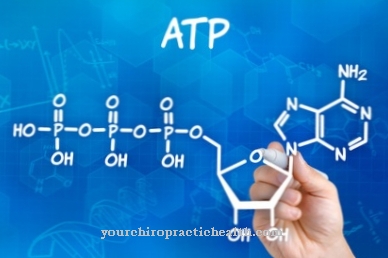Under the term Excitation power one understands the transmission of excitations in nerve or muscle cells. Frequently the conduction of excitation is also called Stimulus conduction from a medical point of view, however, this term is not entirely correct.
What is the excitation conduction?

The conduction of excitation is the basis for the functionality of the nervous system and nerves. Excitation conduction is carried out within nerve cells (neurons) or muscle cells. If, on the other hand, an excitation is transmitted from one cell to another cell, it is known as excitation transmission. This usually takes place in chemical form at synapses. The conduction of excitation itself is a bioelectrical process.
Function & task
There are basically two forms of excitation conduction. The electrical excitation line is passive. It is designed to cover short distances. Electrical stimuli on the axon trigger a depolarization at the specific location. In contrast to the surroundings, the charge here is more positively charged. The difference in charge causes the electric field to develop along the nerve fiber. The wall of the nerve fibers is rather poorly insulated when it comes to electrical conduction. The electric field becomes weaker and weaker with increasing distance and the depolarization decreases. Therefore, only very short distances can be covered with this form of excitation conduction.
The electrical conduction is found, for example, in the outer layers of the retina. The photoreceptors and the bipolar cells of the retina transmit their excitations in this passive way.
The other form of stimulus conduction is stimulus conduction through action potentials. Here, again, a distinction can be made between continuous and saltatory excitation conduction. The continuous conduction of excitation can be found in nerve fibers without myelinated nerves. The nerve impulse is transmitted from section to section as it is transmitted along the nerve fiber. This form of excitation conduction is rather slow with a maximum speed of 30 meters per second. It is mainly found in nerves that supply the internal organs. Nociceptors, i.e. free sensory nerve endings, also pass on their excitations in this way.
The saltatory conduction of excitation is significantly faster. Most of the nerve fibers in the human body are encased in myelin sheaths. These act as a kind of insulation layer. The shift is interrupted at certain intervals. One speaks here of Ranvier's lace rings. With these nerve fibers, the excitation jumps from ring to ring. This enables speeds of up to 100 meters per second to be achieved. In this way, excitations can be directed through the entire body to the target organ at lightning speed.
A special feature of the body is the conduction of excitation in the heart. Here there is a combination of an excitation conduction system with an excitation transmission from cell to cell. The electrical signals that regulate the activity of the heart are passed on via the excitation conduction system. The rhythm is set by the arousal system. It is remarkable that these excitation systems of the heart do not consist of nerve cells, but of specialized heart muscle cells. So that the excitation can spread through the heart, all heart muscle cells are connected to one another via so-called gap junctions. Only through the cooperation of the systems is it possible for the heart muscle that all cells can contract in a coordinated manner.
You can find your medication here
➔ Medicines for paresthesia and circulatory disordersIllnesses & ailments
The term conduction disturbances includes all malfunctions of conduction in the heart. These malfunctions lead to a delayed or interrupted transmission of the electrical excitation. The conduction disorders include the right bundle branch block, the left bundle branch block and the AV block.
With AV block, the AV node of the cardiac conduction system is blocked. This is common in the elderly, but it can also be associated with heart conditions such as heart attack or myocarditis. If the AV block is impaired, the heart rate drops. As a result, the heart's pumping capacity drops and the body can no longer be adequately supplied with arterial blood. In the case of irreversible disorders of the AV block, the patient is given a pacemaker.
In the left bundle branch block the conduction of the left half of the heart is restricted, in the case of the right bundle branch block the conduction of the right heart is restricted. Causes of these phenomena are coronary heart disease, arterial hypertension or myocarditis.
Multiple sclerosis is a disease in which the saltatory conduction is severely impaired. It is a chronic inflammatory disease. The myelin sheaths of the nerve cells of the central nervous system (CNS) are affected. One speaks here of demarking. Foci of demyelinating are primarily found in the white matter of the spinal cord and the brain. The cause of the inflammation is an attack by the body's own defense cells. But why the cells attack the body's own tissue has not yet been clarified.
The first symptoms usually appear between the ages of 16 and 40. The disease progresses in phases. Initially, the symptoms of the relapses usually recede, later deficits remain. The nature of the symptoms depends on the location of the demyelinating foci. Typical early symptoms are visual disturbances such as double vision or blurred vision. Discomfort, numbness or pain can also occur. If the cerebellum and the brain stem are affected, symptoms such as swallowing disorders, dizziness, speech disorders or movement disorders occur. The disease cannot be cured. The therapeutic measures are intended to enable the patient to live as independently as possible.
















.jpg)
.jpg)



.jpg)






